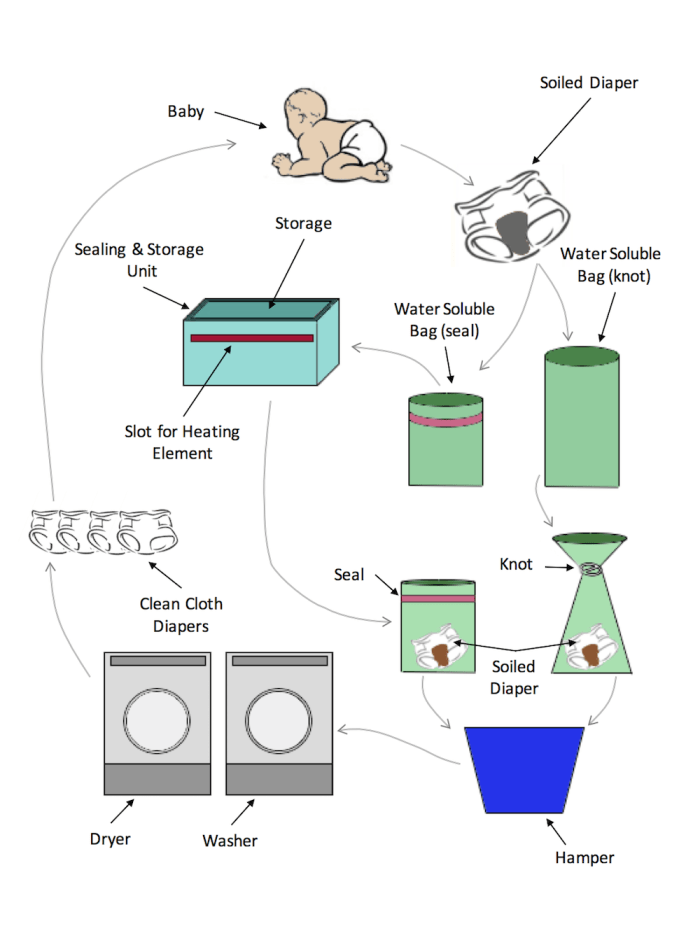An eco-friendly diaper system is introduced for improving children’s diapers. This innovation is easy to use, reduces costs, and eliminates waste and adverse environmental impacts of disposing diapers in landfills.
The solution provides for storing cloth diapers in water-soluble bags and washing them at home. The bags seal in foul odors and conceal the unsightliness of soiled diapers; they are inexpensive and eliminate adverse impacts on the environment.
In the US alone, approximately 20 million children use diapers for about 2 years each. The 3 popular diaper solutions are:
1. Cloth diapers
2. Diaper services
3. Disposable diapers
During the two years of use, cloth diapers cost approximately $450/child, they are unsightly, generate foul odors, and are difficult to manage. Diaper services are very expensive (approximately $2,400/child). Disposable diapers make up 95% of the market and cost approximately $1,500/child. This innovation costs about $150/child, in addition to the cost of cloth diapers.
According to the US Environmental Protection Agency over 27 billion diapers are used annually, making up 2.3% of municipal waste by weight. Over 200,000 trees and over 3.4 billion gallons of fuel are used each year to produce disposable diapers. Various toxic chemicals are used in producing diapers, such as sodium polyacrylate, dioxin, toluene, ethylbenzene, tributyl-tin, xylene, and dipentene. These chemicals are known to cause cancer, infertility, asthma & respiratory distress, hormonal problems, developmental & cognitive problems, diabetes, etc. These chemicals, along with bacteria in fecal matter, enter the local water supplies from the landfills.
The proposed solution advantageously addresses the above problems. The key innovation is storing and sealing soiled cloth diapers in water-soluble bags, so they can be washed at home and re-used. Water soluble bags may be made of materials such as polyvinyl alcohol (PVA), which is safe and already commercially used. Further, PVA can be made in opaque colors and formulated to dissolve in water at pre-determined temperatures, such as the temperature of water in a washing machine.
With reference to the attached illustration, the soiled diaper is placed inside a water-soluble bag, which is opaque in color to hide the unsightliness. The bag may be tied or wrapped to seal it and prevent the release of foul orders. Optionally, a sealing & storage unit may provide a heating element to seal the bag, and store unused bags in a dry dispenser. The used bags are stored in a hamper and washed in the washer/dryer at home, where the bags dissolve during the wash cycle. The washed diapers are reused and the process is repeated. The waste water is processed in the municipal sewage system intended for this purpose.
The benefits include:
• Easy to use and inexpensive
• Reduces manual handling of soiled diapers
• Reduces energy consumption
• Protects the environment and water supplies
• Significantly reduces waste
• Protects children from toxic chemicals
Manufacturing of PVA bags and the sealing & storage unit, as well as the use of the system, are trivial. Production costs are substantially lower than disposable diapers.
Voting
-
ABOUT THE ENTRANT
- Name:Kas Kasravi
- Type of entry:individual
- Profession:
- Number of times previously entering contest:1
- Kas's favorite design and analysis tools:TRIZ invention methodology | 3D printers | Arduino | Rhino CAD software | Tableau | AI Builder | R | SIMUL8
- Kas's hobbies and activities:Music | Photography | Cycling | Kayaking
- Kas belongs to these online communities:LikedIn | Twitter | Facebook | Pinterest
- Kas is inspired by:It's very gratifying to develop a creative solution to solve a problem or improve something. I use the TRIZ invention methodology frequently, as I find that it helps break through psychological barriers and solve problems much better and faster.
- Patent status:pending

